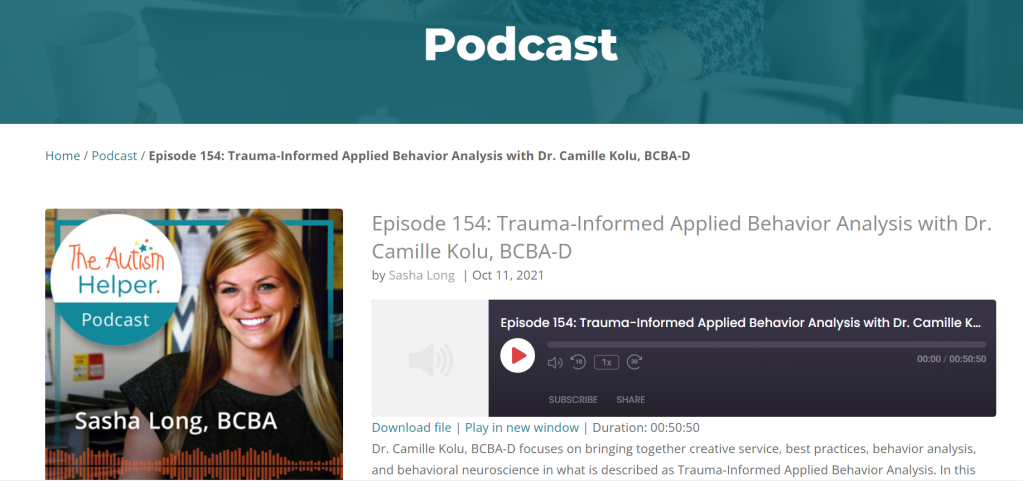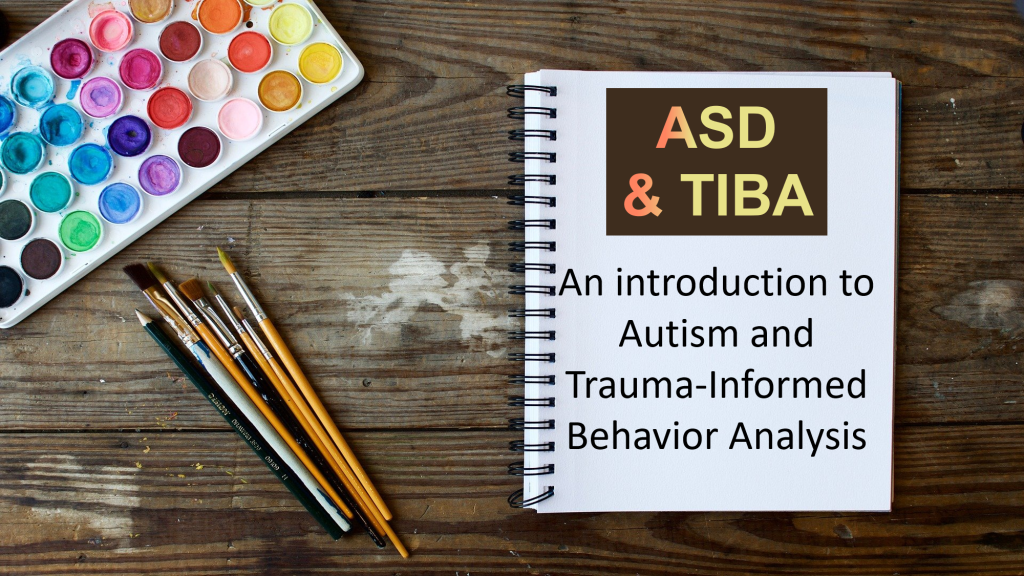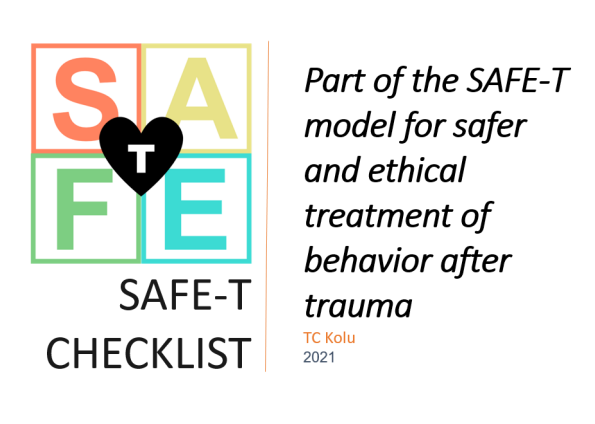This is the 20th article in a series on Trauma-Informed Behavior Analysis by Dr. Camille Kolu, BCBA-D
In medicine, contraindicated procedures are those that are withheld due to the potential harm they might cause to a patient. More and more, behavior analysts are interested in learning about someone’s history, in part to lessen the risk they will do a client harm.
We are tasked, ethically, to do no harm (and see the BACB Ethical and Professional Code item 4.02); to evaluate potential risks and side effects of interventions and to weigh the possible benefits of each (see 2.09 and 4.05); and to avoid using harmful reinforcers or those that require excessive motivating operations to be effective (4.10). For RBTs as well as those certified at higher levels, ethics obligates us to protect our clients from harm (see RBT Ethics Code section 2.02).
In our live webinars (please see CuspEmergenceUniversity.com where we list topics we train frequently on– any course you see there is available as a live webinar training or, in some cases, available as an on-demand training), we receive frequent questions like this:
What kind of procedures should be avoided when working with a new client after certain types of trauma? Are there certain procedures we should give more thought to after a client has been through challenges we know about? What do we do if so?
Given these wonderful questions, today’s post shares a few basic procedures that may be contraindicated – at least at first—given a specific combination of historical factors involving trauma.
Of course, it’s not black and white. Often this should just be the first step for the team, a conversation in which people consider potential for risk conferred by historical variables. The team can then make a more careful decision in order to mitigate possible risks and maximize the benefit of any procedures selected, along the lines of what our code suggests in item 4.05. Though each procedure below is potentially contraindicated at first, it could be appropriate later in treatment, or perhaps from the beginning- the point is that this should depend on an individualized risk versus benefit analysis of the other options available to the team, the client’s history and needs, the severity of the past abuse or neglect or trauma, etc.
- For a client who has experienced previous food insecurity, food related abuse or neglect, and/or severe food deprivation:
One potentially contraindicated procedure is using edible reinforcers.
Notes: Here there are risks to the client, and also potential risks to the client’s relationship with their caregivers and team members. The conditions necessary to establish the motivating operation for reinforcement may be similar to previously neglectful or abusive conditions, or may act as conditioned motivating operations that make harmful behaviors temporarily more likely. In our history treating clients after these circumstances, we have also experienced something related to behavioral contrast in this situation. For example, a client who was provided edible reinforcement in their new applied behavior analysis setting then went home and used dangerous and surprising behaviors related to their neglectful history. The client’s foster family was caught off-guard by these new behaviors, but they could have been predicted during team education on how edible reinforcers might need to be avoided at first when conditioning new team members as reinforcing (and as instruction-related discriminative stimuli).
2. For a client who has been involved in previous sexual abuse (including when the client also makes allegations):
One contraindicated procedure is assigning a 1:1 without additional oversight.
Notes: Here there are risks to both the client and additional team members. When the team receives this case, it would be contraindicated to immediately assign 1:1 support without preventative measures such as training for the 1:1 and supplemental recording, additional oversight or whatever is deemed necessary.
3. For a client who has experienced medical complications from sexual or physical trauma (e.g., this could include incontinence, fecal smearing or related concerns, etc):
One contraindicated procedure is conducting toilet training without oversight from a medical professional, additional training or consultation by someone with expertise in this circumstance, etc.
Notes: In this situation, respondent and operant interactions can occur that are dangerous to treat without expertise; the client can risk serious complications and worsening medical problems; there is a risk of further conditioning the experiences of voiding (and related rituals) as aversive; there is a risk of occasioning behaviors related to the past abuse, or pairing aversive events with team members involved in the procedures; and more.
4. For a client who has experienced previous neglect or adverse circumstances (such as deaths of parents, removal from unsafe conditions, or experiencing war, dangerous immigration or poverty related issues), resulting in deprivation of basic needs and social interaction:
Some potentially contraindicated procedures involve attention related extinction, differential reinforcement of appropriate versus inappropriate requests, or time out from attention reinforcement.
Notes: In this situation, there are safer procedures to begin using that could avoid some of the harmful side effects of removing attention contingent on unsafe behavior. A child with a serious history of neglect may have used behaviors that can seem bizarre or out of context for typical child development, but that were critical to the child’s survival. At the same time, it may not be appropriate to pair new team members with procedures that were used in the child’s neglect, even if the “intent” is different. There are many procedures that can be used more safely, such as using enriched environments and fixed time schedules, to provide monitoring, insure high levels of safe attention, and begin to condition adults as neutral stimuli again, if needed, after harmful interactions with adults in the person’s past.
5. For a client who has been affected by physical and/or sexual abuse, behaviors and circumstances consistent with reactive attachment disorder, or multiple and changing caregivers in childhood:
One potentially contraindicated procedure might be contingent praise statements to establish compliance related behaviors.
Notes: In this situation, a client may have had a history in which adults could not be trusted, behaved inconsistently or inappropriately, or paired unsafe and harmful actions with typical caregiving behaviors. Clients who experienced this may initially present as lacking “a compliance repertoire”, but it may be contraindicated to attempt to establish and praise compliance, for several reasons. Some may be overly compliant, and lack self-help and self-advocacy repertoires that are critical to autonomy; if they are still going home at night after the school day to an unstable situation or multiple foster homes, to praise rigid compliance may increase the risk of further victimization or contribute to future abuse. At the same time, initial praise for compliance may damage relationships between the client and new caregivers who have not “earned” the right to praise the client’s behavior by establishing a history of consistency and helpful interactions. Furthermore, praise might already be conditioned as aversive for the client and could sabotage the caregiver’s attempts to establish a relationship or instruct appropriate behavior. (CuspEmergence.com has written elsewhere about praise here).
6. For a client who has been affected by neglect, and involved with law enforcement, suspensions and challenging behavior:
A potentially contraindicated procedure is least to most punishment.
Notes: Implementing punitive procedures (or procedures that educators assume to be aversive and are using to control behavior) in a “least-to-most” order is dangerous, especially after the interactions mentioned here. Any time punishment is implemented in a LTM order, we risk these outcomes: conditioning the aversive stimuli becoming more reinforcing, and more familiar; worsening the client’s behavior as they need to contact more and more of the supposedly aversive stimulus; pairing the people administering the punishment with aversive control, making it more likely the client will (to speak loosely) act out more and more for their high-quality attention; etc. (CuspEmergence.com has written about the potential pipeline from special education to prison here, in an article referencing some of these concerns and containing behavior analytic references.)
7. For a client with symptoms or diagnosis of trauma-related disorders or needs:
A potentially contraindicated thing to do is recommending or implementing applied behavior analysis without any mental health or trauma-focused treatment or input.
Notes: Behavior analysis (at least the kind I provide and teach about) is not a trauma treatment. We are also not a source of diagnosis for trauma. Instead, I work in a complementary way with a team and/or family that is interested in learning about risks related to trauma history, and how these risks affect the person’s behavior, needs, and supports. There are therapies that can provide trauma-focused treatment and aid a person to heal after experiencing difficult circumstances; a person may need these in addition to, or before, receiving behavior analysis to aid them in developing a safe, expanded behavioral repertoire. If someone trusts you with their trauma history, please be careful and supportive.
In closing, for a client with a specific conditioning history, the contraindicated procedure would likely involve aversive conditions and potentially medical or biological variables. Always consider items 3.02 and 4.08 from our Professional and Ethical Code, and discuss whether they apply to your case:
3.02 Medical Consultation. Behavior analysts recommend seeking a medical consultation if there is any reasonable possibility that a referred behavior is influenced by medical or biological variables.
4.08 (d): Behavior analysts ensure that aversive procedures are accompanied by an increased level of training, supervision, and oversight. Behavior analysts must evaluate the effectiveness of aversive procedures in a timely manner and modify the behavior-change program if it is ineffective. Behavior analysts always include a plan to discontinue the use of aversive procedures when no longer needed.”




